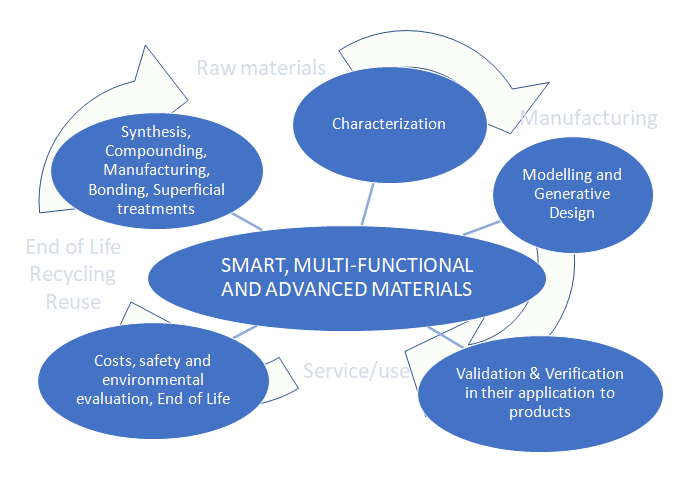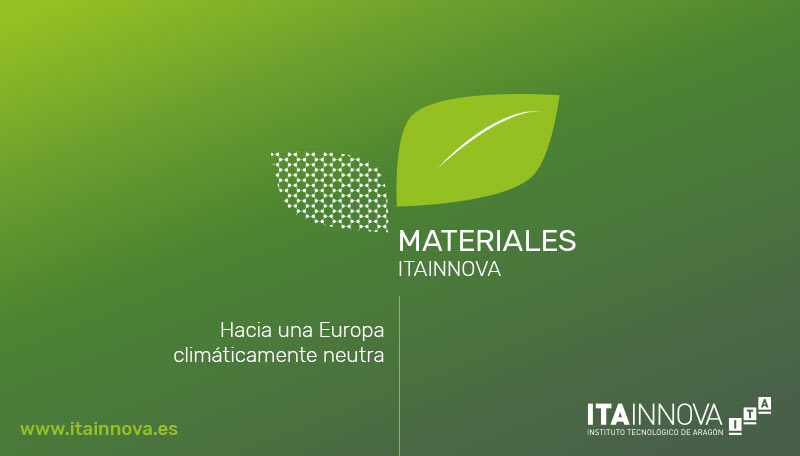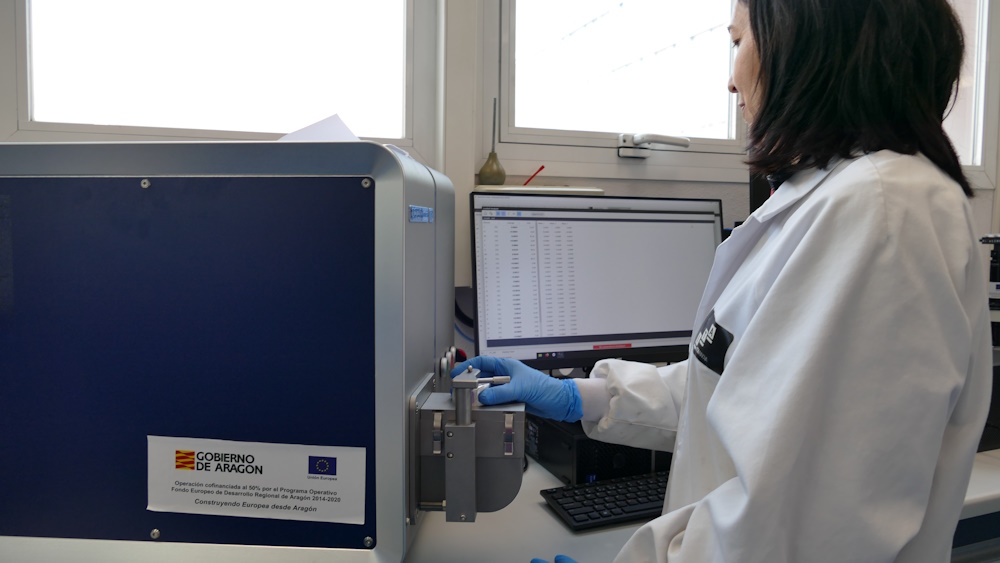Smart and multi-functional materials for sustainability
Materials science to improve our world
Research and innovation within the materials science framework constitutes one of the routes to address many of the technical, economic and environmental challenges we currently face in several sectors and applications. The development of smart materials and materials with new or improved properties/functionalities can provide solutions for many of the industrial challenges that exist today [1-3].
For this reason, it is one of the R+D+i fields derived as action to respond to the missions defined nowadays in Europe, as reflected in the call for proposals of the Horizon Europe programme [4] . In the same line, the developments driven from companies from different industrial sectors, in particular transports, are also numerous [5-7], evidencing again the potential and the opportunities offered by these materials
Promoting sustainable development
Sustainability implies the continuous search of a balance between economic growth, environment protection and social welfare. From this point of view, the development and implementation of smart and multi-functional materials can allow to achieve some of the following impacts that directly or indirectly revert to a more sustainable industry:
- Lifetime extension of products, components and structures, improving their life cycle, and reduction of maintenance operations, with the consequent energetic and economic savings: through a modification/enhancement/control of some specific mechanical properties related with durability and damage tolerance, achieved at material level, or enabling the incorporation of SHM technologies (Structural Health Monitoring) based on materials with self-sensing capabilities.
- Weight reduction & more efficient use of materials, leading to a reduction of the consumption of fossil fuels, energy consumption and decreasing the level of emissions: obtained through materials with better specific mechanical characteristics (i.e. properties-to-density ratios), materials & technologies that allow to obtain target or even graded properties, offering new opportunities for products design optimization, or materials enabling functions integration.
- Improvement of products recyclability, reuse, recovery and repairability: in this case obtained through materials with ad-hoc capacities for these processes, such as those that incorporate degradation mechanisms that can be controlled on demand.
- Development of new devices or systems that allow the improvement of the energetic efficiency of processes or of the service life of other products or equipments, or the control of the environmental impact of them: as sensors, new energy storage systems (batteries, capacitors), energy harvesting systems, to mention some of them.
A challenge for materials science
Materials development processes taking into account sustainability involve a combination of aspects and disciplines that arise while considering together technical issues, typical of materials engineering, economic, and the complete life cycle of materials or the products on which there are used.
Thus, in first place the questions related to the synthesis and manufacturing processes, the materials modeling and simulation, the characterization techniques, and the data optimization and analysis methodologies appear, in which chemistry, physics and engineering are mixed.
In the application to products, the development of smart and multi-functional materials generally presents a high level of complexity, since it turns into the implementation of new materials that must respond to a larger number of requirements. In both cases, the introduction of a controlled and repeatable response capacity to certain stimuli (such as definition of smart material) or the incorporation of functions, produce a greater amount of requisites that must be met simultaneously depending on the product/component on which they are used.
As an example, aircraft wings with the ability to change their shape that are being currently investigated in search of improvements in the consumption and energy efficiency of airplanes, must meet the requirements related with this new functionality in addition to the ones that apply to standard wings.
But, in addition to the costs, the concept of sustainability makes the criteria related with the environmental performance and health/safety acquire equal relevance, which must be incorporated to the development processes:

This highlights the need for methodologies and strategies that allow these processes to be carried out effectively and efficiently, this being one of the current challenges for materials science and engineering.
Regardless of the above, the range of materials and technologies that fall into the ‘smart and muti-functional materials’ category is enormous, and the development needs can be very different depending on the case. In this sense, some specific examples of this type of materials are:
- Materials with special/additional functionalities: self-revealing (i.e. damage), self-healing, controlled/on demand degradation, materials with specific superficial properties (self-cleaning, anti-icing, anti-wear, self-demoulding, hidrofobic, …)
- Smart materials: self-sensing, materials with electric or induction heating capacity, shape memory or morphing materials, phase change materials, 4D printing materials, piezoelectric, dielectric elastomers, photo-active, chromo-active, magnetorheological, among others.
- Materials with thermal, electrical, magnetic or mechanical enhanced properties, functionally graded materials, self-reinforced materials.
From this broad range, the application examples are also very varied and cover diverse fields, which could lead to very different requirements depending on the case
Smart and multi-functional materials at ITAINNOVA
The Aragon Institute of Technology has been working within the field of smart and multi-functional materials for years, where, for example, it has developed projects to produce elastomers with self-sensing capabilities (determination of level of strains from the measurements of electric properties), nano-reinforced polymers to obtain specific mechanical properties enhancements, and studies of superficial texturing to improve tribological properties (wear and friction).
As a recent case, within the framework of the European project SmartFan (currently on-going) ITAINNOVA has been developing polymers and composites with self-revealing properties, facilitating cracks detection in visual inspection methods. This is achieved in this case through the incorporation of micro-capsules that contain fluorescent substances that allow to identify fissures and micro-cracks by means of UV lamps:
Another development done in the same project is the modification of polymers with magnetic nano-particles (MNPs) to introduce induction heating capacities without affecting notably the rest of characteristics.

Within SmartFan, the materials development activities and those necessary for their implementation in products are combined with economic and environmental analysis to obtain a global evaluation of the technologies. In this case, this has been achieved through the collaboration between different partners. In this way, the project constitutes a clear example of the processes previously mentioned, necessary to obtain sustainable smart and multi-functional materials

programme under grant agreement No 760779
ITAINNOVA committed to #ClimateNeutrality.
References
(1) Advanced materials, European Commission
(2) 6th World Materials Summit: outcome – MATERIALS INNOVATION FOR THE GLOBAL CIRCULAR ECONOMY AND SUSTAINABLE SOCIETY, Council of Europe, Strasbourg – 20th & 21st November 2017.
(3) Research and Development in Carbon Fibers and Advanced High-Performance Composites Supply Chain in Europe: A Roadmap for Challenges and the Industrial Uptake, E. Koumoulos, A. Trompeta, , R. Santos, M. Martins, C. Monterio dos Santos, V. Iglesias, R. Böhm, G. Gong, A. Chiminelli, I. Verpoest, P. Kiekens and C. Charitidis, J. Compos. Sci. 2019, 3, 86; doi:10.3390/jcs3030086.
(4) Horizon Europe Work Programme 2021-2022: HORIZON-CL4-2022-DIGITAL-EMERGING-01-20: 2D-material-based composites, coatings and foams (IA), HORIZON-CL4-2022-RESILIENCE-01-13: Smart and multifunctional biomaterials for health innovations (RIA), HORIZON-CL4-2022-RESILIENCE-01-11: Advanced lightweight materials for energy efficient structures (RIA), HORIZON-CL4-2021-DIGITAL-EMERGING-01-13: Academia-Industry Forum on Emerging Enabling Technologies (CSA), HORIZON-CL4-2021-RESILIENCE-01-12: Safe- and sustainable-by-design metallic coatings and engineered surfaces (RIA).
(5) Using smart materials to solve new challenges in the automotive industry, Kerrie K. Gath, Clay Maranville, Janice Tardiff, Proceedings Volume 10602, Smart Structures and NDE for Industry 4.0; 1060202 (2018) https://doi.org/10.1117/12.2296622, March 2018.
(6) Faurecia to create sustainable, smart materials division, targets EUR 3 b sales, https://auto.economictimes.indiatimes.com/news/auto-technology/faurecia-to-create-sustainable-smart-materials-division-targets-eur-3-b-sales-by-2030/84669570.
(7) https://www.sustainair.eu/2021/07/13/3-ways-to-close-the-loop-for-aerospace-materials.


Agustín Chiminelli
ARTÍCULOS DEL MÍSMO ÁMBITO
-
EL ANÁLISIS QUÍMICO DE MATERIALES METÁLICOS: GARANTÍA DE DURABILIDAD Y CALIDAD
Miércoles, 20 Marzo 2024
- Ensayos
- Industria circular
- Materiales
-
LA 3ª EDICIÓN DEL T-PROGRAM COMIENZA EL 28 DE FEBRERO
Viernes, 19 Enero 2024
- Big Data y Sistemas Cognitivos
- Industria 4.0
- Internet of Things (IoT)
- Mecatrónica
- Robótica
- Sistemas Eléctricos
- Smart Labs
OTROS ARTÍCULOS
-
Materiales ligeros para fabricar vehículos más sostenibles
Jueves, 27 Junio 2024
- Diseño y desarrollo de vehículos eficientes
-
Comunidades energéticas: beneficios de la IA para la producción y gestión de la energía
Martes, 25 Junio 2024
- Sistemas de generación eficientes











